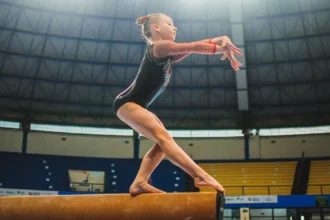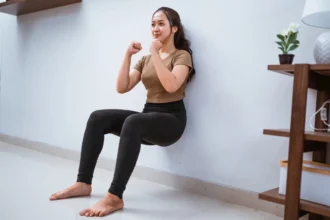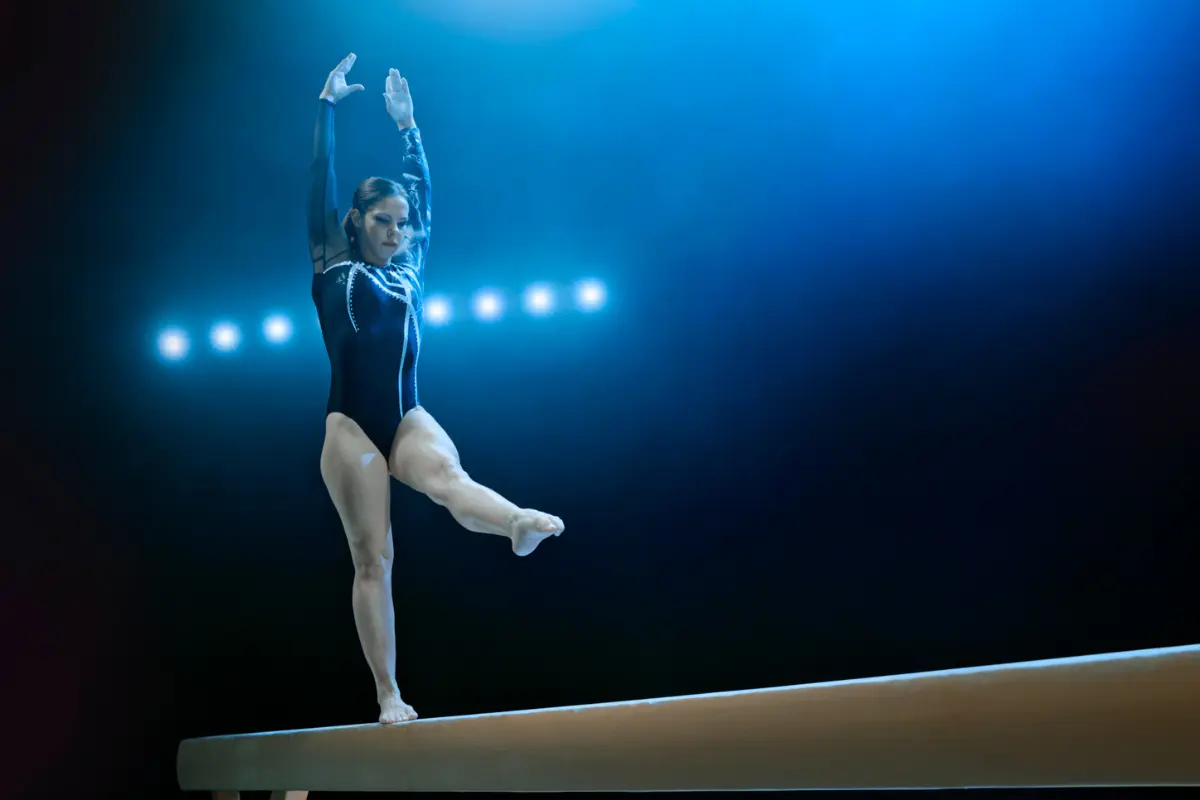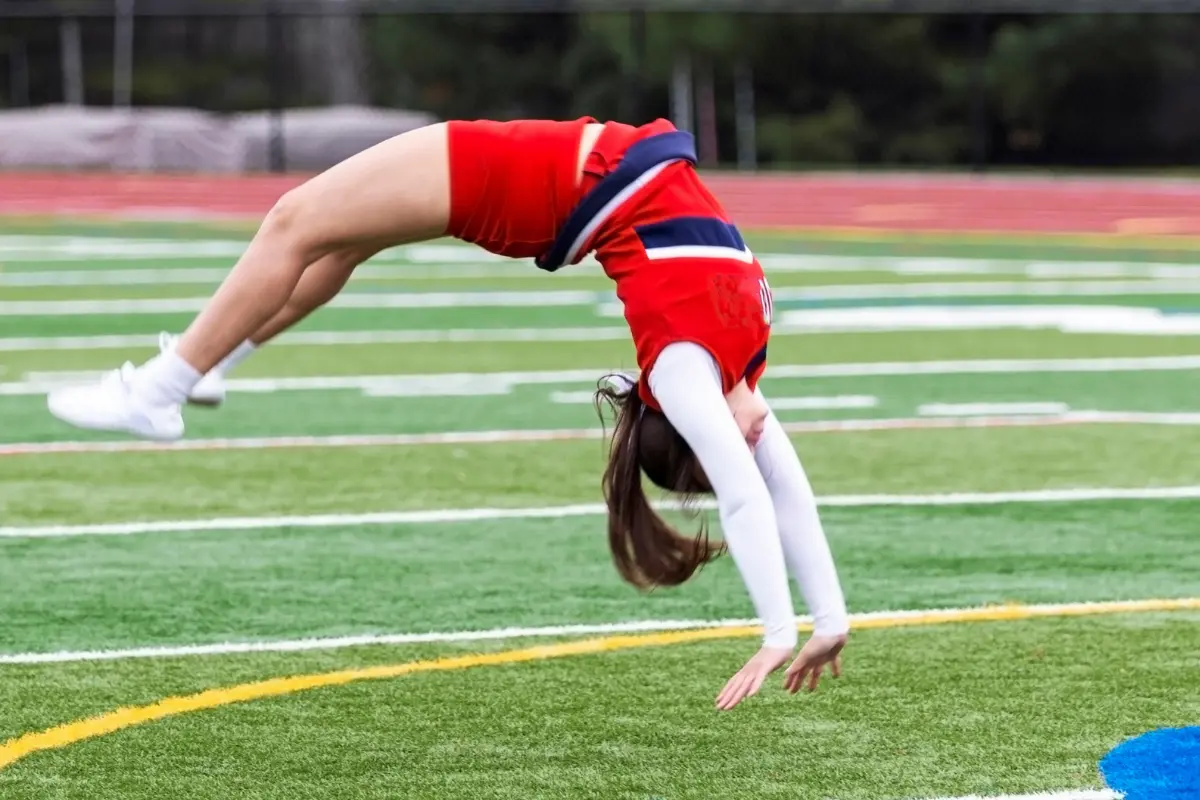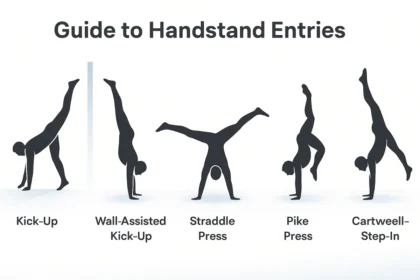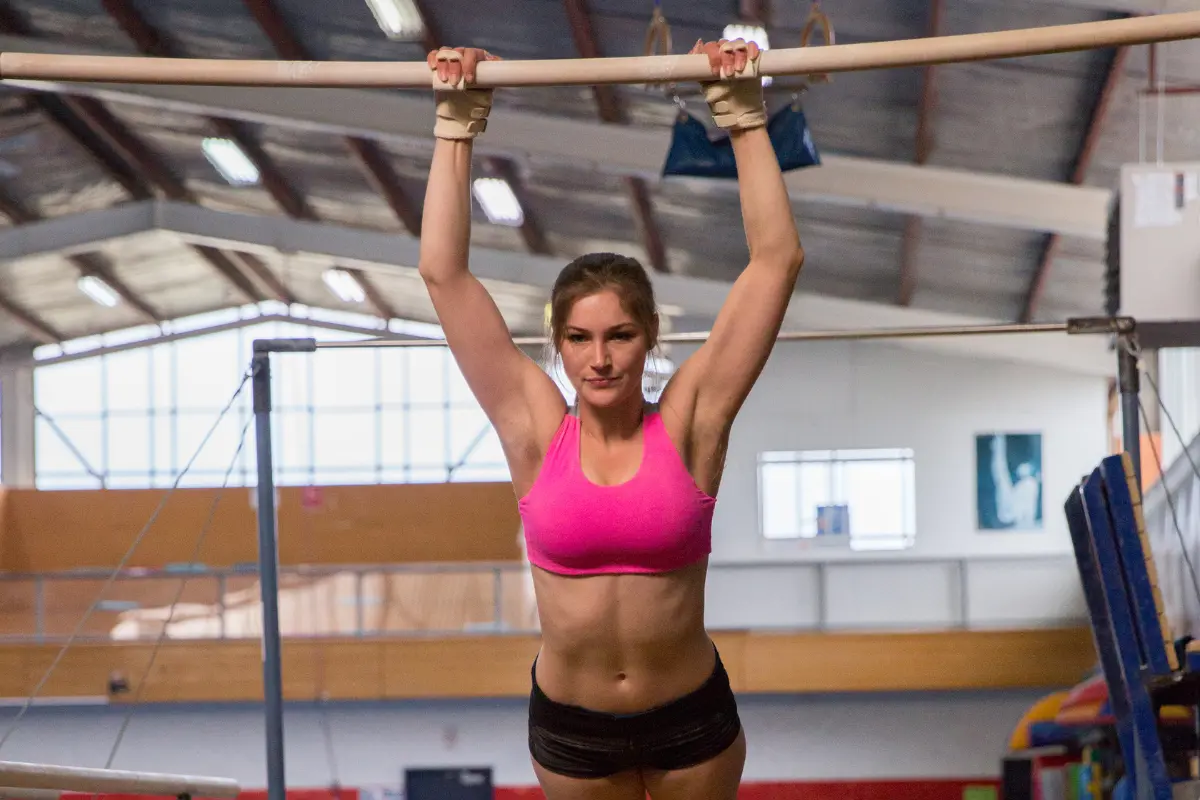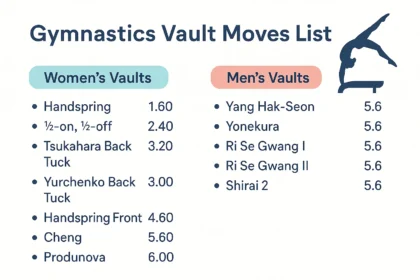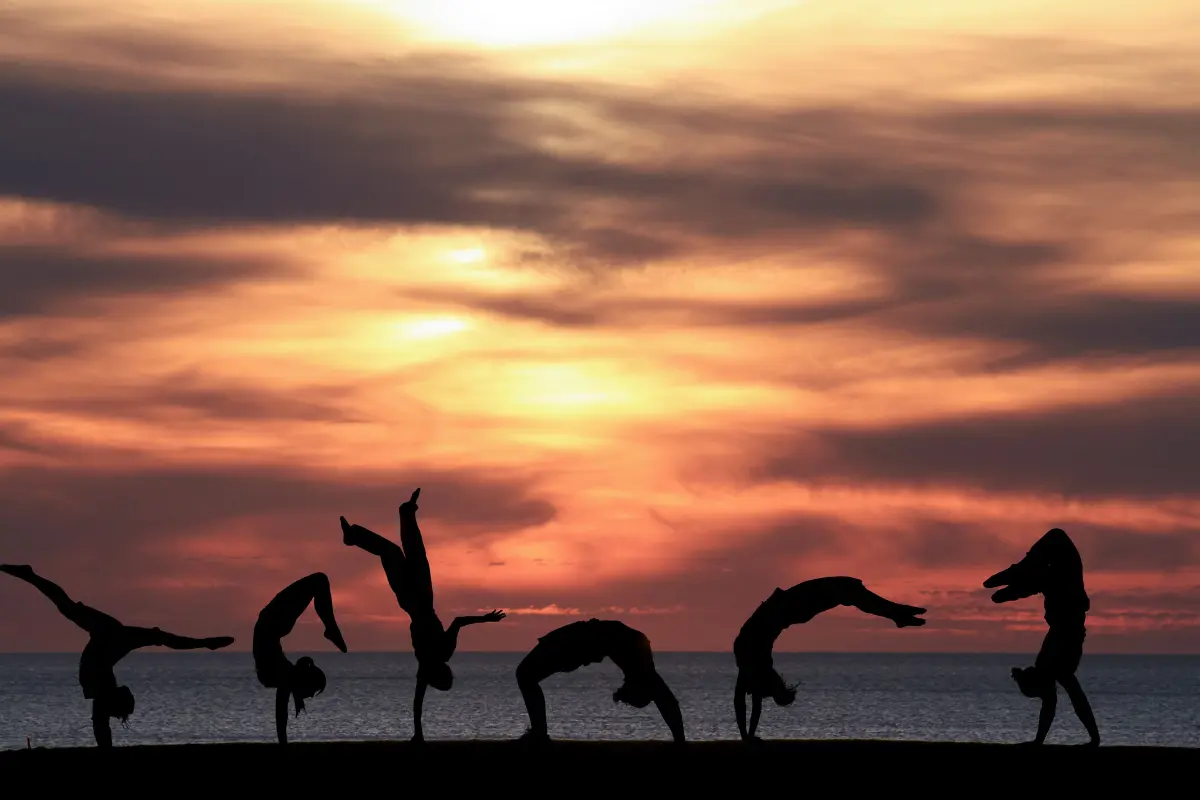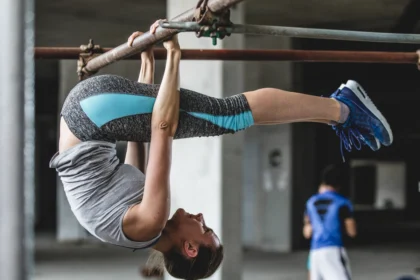The start of a beam routine isn’t just an entrance—it’s a scoring opportunity. A gymnast’s mount sets the tone, shapes the first impression, and contributes directly to the Difficulty Value (DV). Under the 2025–2028 FIG Code of Points, mounts are classified as Group 1 elements. They can earn DV, qualify for connection bonus, and be penalized for execution and artistry mistakes. A well-performed mount can add up to 0.40 in DV, equal to many acro skills.
Yet mounts are often performed cold, from floor level, without a podium warm-up. That makes them one of the riskiest moments of the routine—demanding confidence, control, and smart planning.
Contents
Categories of Beam Mounts
Mounts fall into three general types, each suited to different skill levels and routines.
1. Simple Mounts (Support Mounts)
Used most in compulsory and lower Xcel levels, these prioritize balance and control over difficulty.
- Jump to Front Support – Land in a push-up position.
- Straddle Mount – Swing one leg over to sit in a straddle.
- Jump to Side Sit – Turn mid-air and land in a seated side position.
They’re low-risk but still judged on form, tightness, and connection to the next skill.
2. Acrobatic Mounts (Acro Mounts)
These showcase power and coordination and are common in upper optional, Xcel, and elite levels.
- Back Walkover Mount (B) – Enter the beam from a walkover on the floor or springboard.
- Front Handspring Mount (B) – A dynamic, forward entry landing on the beam.
- Cartwheel Mount (B) – A sideways entry, finishing seated or standing.
Acro mounts increase start value and wow factor—but demand precision to avoid falls.
3. Dance and Creative Mounts
Focused on flexibility and artistry, these mounts help gymnasts stand out stylistically.
- Split Jump Mount (A) – Leap into a side split on the beam.
- Press Handstand Mount (A) – Press slowly to handstand, then lower into choreography.
- Shoulder or Dive Roll – Enter the beam in a rolling, theatrical motion.
These mounts shine when performed with clean lines and choreography that flows.
How Mounts Are Valued and Judged
Mounts are scored based on their Difficulty Value (DV) and how cleanly they are performed. Here’s how judges assign value:
| DV | Examples | Risk & Reward |
|---|---|---|
| A (0.10) | Step-up leg swing, side split jump | Easy and consistent; good for compulsory/Xcel Bronze & Silver. |
| B (0.20) | Press handstand, cartwheel mount | Reliable with added polish; seen in NCAA and optional levels. |
| C (0.30) | Front tuck, press handstand pirouette | High value; demands precision and core strength. |
| D–E (0.40–0.50) | Layout step-out, front pike mount | Visually striking but unforgiving—falls cost 1.0 and erase DV. |
Judges also deduct for bent knees, pauses, flexed feet, wobbles, and poor transitions into the routine. Up to 0.30 artistry deduction can be applied for breaks in rhythm or flow.
Connection bonus is available in upper levels if a B+ mount connects directly into another skill—like a split jump or leap.
Source: The Gymternet, naigc.org
Beam Mount Requirements by Program (2025–2028)
This quick-reference guide outlines what the official codes say about beam mounts across all major women’s levels in U.S. and international competition.
USAG Development Program – Compulsory Levels (1–5)
Levels 1–2
Everyone does the same mount at these early levels: a jump to front support, followed by a ¼ turn into a straddle sit. It’s a basic A-valued skill worth 0.20. You can’t modify or upgrade it, and it doesn’t fulfill any other requirements. What judges care about most here is form—straight arms, tight body, and a clean transition into the next move.
Levels 3–5
The mount changes slightly to a fish-pose variation from front support, but the approach is the same: fixed skill, no substitutions, and no bonus opportunity. To earn points, gymnasts need perfect body alignment and a seamless flow into the routine.
USAG Development Program – Optional Levels (6–10)
Once gymnasts reach Level 6, they can pick any mount from Group 1 in the Code of Points—ranging from A through E. This gives athletes the chance to boost their Difficulty Value (DV) or even earn connection bonus by linking their mount to another skill.
However, the mount cannot count toward the required acro series (the two-flight-element rule). So even if you do a back walkover onto the beam, you still need a separate acro series later in the routine.
Pick a mount that’s reliable. Even if it’s simple, landing it cleanly can set up the rest of the routine with confidence.
Xcel Program (Bronze to Diamond)
In Xcel, mounts are required—but how hard they can be depends on the level:
- Bronze & Silver – A-valued mounts only
- Gold – Up to B
- Platinum – Up to C
- Diamond – Up to D (E-level not allowed)
Mounts in Xcel don’t count toward fulfilling any dance, leap, turn, or acro-series requirements. Their only job is to get the gymnast on the beam with style and control—and add a bit of start value. Keep it simple, clean, and connected to choreography.
NCAA Women’s Gymnastics
College athletes can choose any mount from A to E. That mount’s value is added into the routine’s required skill mix of 3 A’s, 3 B’s, and 2 C’s (or harder).
If the mount includes flight—like a round-off into layout step-out—it may count as one of the acro-series flight elements, as long as it meets all the requirements. But you can’t connect it directly into the dismount for bonus credit.
One big thing to watch: pauses. If a gymnast lands the mount and hesitates too long before starting the routine, judges may deduct 0.10 to 0.30 for breaking rhythm. Smart choreography should flow immediately into the next element.
FIG Elite (Women’s Artistic, 2025–2028 Code)
In elite-level international competition, the rules are simple but strategic:
- The routine must begin with a Group 1 mount.
- Only the highest-valued mount (A to E) will be credited.
- Any additional mounts are ignored.
There’s no separate mount requirement, but your mount can help fulfill a dance-series requirement or earn connection bonus—if you link it directly into another element like a leap or turn.
Elite coaches often weigh two things:
- Whether the mount meaningfully increases the D-score.
- Whether it’s worth the risk of performing a difficult skill cold, without warm-up.
Final Tips: Putting It All Together
- Compulsory gymnasts should focus on perfecting the assigned mount with strong body positions and clean transitions.
- Optional, Xcel, and NCAA athletes must weigh the value of the mount against how consistently it can be performed.
- Elites should balance start-value potential with performance risk—especially under pressure.
Golden Rule: Pick the most difficult mount your gymnast can land confidently, then practice it until it becomes second nature.
Signature Mounts Broken Down
Below are five coach-tested mounts that span every Difficulty Value (DV) bracket, from basic A-level entries to elite E-level acrobatic mounts.
🟣 Jump to Side Split — A (0.10)
This beginner-friendly mount involves a leap into a side split on the beam. Key points include square hips, 180° split, and a centered landing. Common faults are bent knees and poor leg extension. Use panel mats and half-beam drills to sharpen form.
🔵 Press to Handstand — B (0.20)
Starting from an L-sit or straddle, the gymnast presses to a handstand with extended arms and elevated shoulders. To earn credit, the handstand must be held for two seconds. Typical mistakes include hand adjustments and piking up. Wall presses and low-beam drills build strength and control.
🔶 Front Tuck Mount — C (0.30)
A powerful forward tuck onto the beam that requires tight form and timing. Common issues include low hips, pauses, or unstable landings. Use mini-tramps and pit-beams for early reps before moving to regulation height.
🔴 Round-Off → Layout Step-Out — D (0.40)
This advanced mount begins with a round-off followed by a stretched layout step-out. Precision and alignment are key. Deductions come from soft knees or off-line landings. Use chalk targets and wedge beams to refine.
🔺 Front Pike Mount — E (0.50)
An elite, blind-landing mount with high risk and reward. The gymnast must drive the heels, maintain tight core control, and connect seamlessly into choreography. Practice with resi-pits and low-beam drills before progressing to full-height attempts.
Choosing the Right Mount for the Athlete
The best mount strikes a balance between difficulty, artistry, and consistency. It sets the tone for the routine and must match the gymnast’s level and confidence.
- Competitive Level: Simpler, consistent mounts are best for compulsory levels. Higher-level athletes might opt for riskier entries that boost DV if they have reliable follow-up elements.
- Routine Composition: Avoid stacking too many intense skills. High-effort mounts should be followed by recovery moments in choreography to maintain performance quality.
- Connection Potential: Mounts valued B or higher can link to dance skills (e.g., press to split jump) for a 0.1 bonus, adding to difficulty and fluidity.
- Athlete Psychology: Some gymnasts thrive with a hard mount; others need a calm start to stay focused. Try both in practice to see what works.
Ultimately, the right mount supports the gymnast’s strengths, builds confidence, and fits the routine’s flow.


